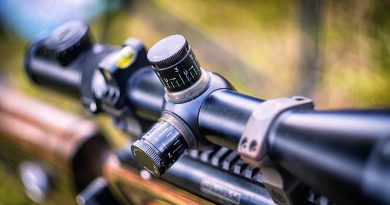A New Guide on The Best Night Vision Goggles
The lack of available light during late hours make eyesight difficult even with a full moon. Thankfully technological progress gave us lots of night-vision solutions start from 1930. We are extremely excited about getting you to know more about night vision. That’s why in this article we’ll talk about the differences of night vision devices, what kind of night vision do you need, and how to choose it right. Also, at the end of the article, you may find a piece of advice on the best gear you need to become a professional.
But first, let’s talk about what made night vision devices work. We’ll tell you about generations. No, not the whole story start from the Vietnam war, but only the most essential principles to find out how it works and what makes gen 1 different from Gen 2, 3 and 4.
Night vision devices rely on ambient light to produce an image. The most significant part is intensifier tubes that amplify light about 1,000 times greater than the human eye.
Gen 1
A long time ago it was the most popular technology, but we do not recommend buying it nowadays because of low resolution, blurry edges, and dependency on infrared illuminators.
Gen 2
Start from the 80’s it made significant improvements to the Gen 1 tubes inside the device by adding a microchannel plate to help increase light gain and resolution. But the light sensitivity stayed the same as the Gen 1 night vision device.
Gen 3
The Gen 3 devices became the next step in night vision technology. It uses the same technology as Gen 2 but it adds a chemical to the tubes photocathode screen. That’s why Gen 3 devices have the clearest and the brightest images. What is more, the tube life has increased up to 10,000 hours.
One meaningful disadvantage of Gen 1, 2, and 3 is that it can be easily harmed by light exposure.
Gen 4
Sure, it’s better than Gen 3, but the prices are biting. Like Gen 3, it can do everything only clearer. You can use it even in the daytime. This technology creates creat images with the best recognition and detection range. Get it if you can afford it or if your life depends on the night vision.
Best Night Vision Goggles
Now, when you know which aspects pay attention at, let’s move forward and see what manufacturers have prepared for us.
AGM NVG-50 NL1
The night-vision goggle game can be expensive to break into. Quality devices can cost a thousand dollars but, believe it worth it. AGM NVG-50 NL1 is our favorite model. This is due to the price-quality ratio. It has a great field of view (51°) and provides a large visual field without needing to move the binoculars. The NVG-50 uses advanced multi-coated optics and is built to last with compact composite housing. Operating from a single AA alkaline battery or CR123A battery, the NVG-50 can run up to 20 hours. With equipped integral infrared illuminator you will be able to read in the dark. This device has one of the best pictures we’ve ever seen through a pair of night-vision goggles.
Pros
- Gen 2+ Intensifier Tubes
- Multi-coated optics
- Long-lasting battery
- Clear picture
- Comfortable design
- Use as a Binocular or Monocular
Cons
- You may not actually see ghosts
So, AGM NVG-50 NL1 is a fantastic piece of equipment that’s a good choice for people who want a long-lasting high-quality goggles. Wide field of view and compact, versatile design—making it one of the best variants to provide maximum situational awareness and satisfy all your personal needs.
Nightstar 1×20
The Nightstar 1×20 is a binocular set that comes with headgear, a flip-up mount, and a built-in infrared illuminator. The cool part about it is it’s got a 44° field of view. Using this device you are getting twenty hours, which is more than a whole night. One more awesome thing we love in this binocular is the design and simplicity.
But it also has some obvious disadvantages. The goggles are heavier than others of the same size. Also, the process of adjusting the lenses is easy, the absence of eye-distance adjustment make this binocular less universal.
Pros
- Built-in infrared illuminator
- 44° field of view
Cons
- Eye distance cannot be adjusted
- Too heavy
If you are limited in budget and want to have a binocular The Nightstar 1×20 can be a great choice.
Sightmark Ghost Hunter Kit
The Sightmark Ghost Hunter is a 1×24 great unit that’ll satisfy most of your night vision needs. One of the most important features is that this unit is quite compact and lightweight. An impressive detection range of 87 yards makes this device quite powerful. Goggles come with a headset-mounting unit, they are easy to use thus they will be a good choice for new users. One more thing we love about Ghost Hunter is that it protects your eyes from sudden light by built-in automatic shutoff feature.
Pros
- Compact and lightweight
- Comes with a headset-mounting unit
- Automatic shutoff feature
- Perfect for new users
Cons
- Capture could be better
No matter where you will use it, we think that Sightmark Ghost Hunter Kit is amazing optics that will be a great choice for beginners.
Yukon Tracker 1×2
The Yukon Tracker 1×24 is a first-generation night-vision goggle device that includes a fully adjustable head mount so you have everything you need for basic night vision without having to spend a lot of money on additional helmets, etc.
Its main feature is to provide the user with the possibility to see further when the night is brighter. However, the built-in infrared illuminator is sufficient for short-range illumination, up to about 75 yards, users report that they can identify everything at 250 yards during clear nights.
The whole system is more comfortable than many of night-vision goggles, though it may take some time for the rubber cup to conform to your face.
Although this model is easy to adjust, it has a short battery life. The Yukon Tracker 1×24 is an affordable google device because it also includes head-mount.
Pros
- Hands-free solution
- Head-mount included
- Good price
Cons
- Short battery life
- Lackluster field of view
So, if you don’t want to buy a separate head-mount system and looking for a reliable device for your casual or hunting issues The Yukon Tracker 1×24 might be a great choice.
ATN NVG7-3
ATN’s NVG7-3 is the third-generation version of ATN’s NZG7 series. First of all, ATN NVG7-3 comes with a very comfortable and fully adjustable head strap. The device has superfast lenses for optimal resolution and has a lens piece with a little hole at the end that protects your eyepiece. The system also allows you to use it in higher light conditions, even in daylight if the cap is on. The device also creates less eye-fatigue which is significant for a hunter and adventure lover!
You may ask, what is the purpose of using night-vision goggle during the daytime? It’s a great way to test them out and to make sure your goggles operating perfectly before you need them at night.
The device has built-in infrared illuminator and low-battery indicator. The body is lightweight, compact, and rugged, being waterproof and fog-resistant. You can use the NVG7-3 as handheld binoculars or attach it to the included head mount for flip-down, hands-free use.
The device has a powerful battery that will serve you for more than 60 hours. This model shouldn’t tire your head or neck out too quickly.
Pros
- Third-generation night vision
- Built-in IR and low-battery indicator
- Waterproof and fog-resistant
Cons
- Expensive
We think ATN NVG7-3 is an excellent choice for your not only your night vision but the day vision needs!
Sightmark Ghost Hunter 1×24
Sightmark Ghost Hunter series doesn’t just include the unmagnified version. You can also get the Ghost Hunter 2×24 and 4×50 versions.
The device is Gen 1 technology, has a built-in IR-illuminator, two-double -a-batteries that is nice to use instead of something pretty common. The battery life is near 72 hours without the IR, and 20 hours with IR illuminator. A useful low battery indicator will give you a heads up before they lose power. What is more, it does have an auto-shutoff feature, so if you are looking at a bright light it will protect your device from burning. Among the proses is that you have to adjust each lens separately.
One of the things that come in the box with instruction manuals is a head mount which is pretty much worthless. Yes, it has a locking mechanism where you can lock a binocular in different positions but we recommend buying a helmet.
Pros
- Built-in IR illuminator
- Long battery life
Cons
- Worthless head mount
- Have no activation sound like in video games
ATN PVS-7P NVG Gen 3s
The front has the focus and it also has a locking ring that allows you to lock the depth of field. It’s powered by two double-a batteries at the top. When using the PVS-7 unit we ask that you make sure you leave the lens cap on until you’re in the field in dark conditions to avoid damaging sensitive internals and also just to protect the glass from any scratches. On the top of the unit, we have the option to mount your PVS-7 to your helmet. You can use it just pressing the button and then obviously removing the same exact way. When you are not using your googles you better keep it in the field case to ensure that it doesn’t get damaged.
Pros
- Designed to be mounted to a helmet
- Powered by two double-a batteries
- Has built-in automatic brightness control
Cons
- You may not actually see ghosts
Know What You Need To Get the Right Gear
Helmet
The first and most essential thing is a helmet. Sure, most systems will come with a strap head mount. But the helmet is such a part of your equipment that makes you look cool.
So you need a helmet.
While choosing you should make sure you have the standard “shroud” in the front for attachments.
Of course, it should be lightweight to get rid of a couple of pounds around your neck and your head.
Mounts
Attaching your goggles to a helmet should give fantastic adjustability to escape accidents where they are falling off. That’s why mounts were invented! Super easy to use models are reliable but sometimes the price can be rather expensive. We can recommend Wilcox mount, a model where the quality worth the price.
Illuminators
As we already mentioned, the night vision amplifies ambient light. But what to do if there’s no ambient light? The answer is: Buy an IR illuminator, right!
Some models have built-in illuminators but they are not powerful enough to provide you comfortable and safe hunting.
IR Lasers
You know how difficult it is to look through your sights with night vision goggles. IR laser was manufactured to help you decide on this problem. It works just like a visible laser, providing you to use the beam as an aiming point. IR lasers are effectively used as a target and locational designators all over the world.
Autogate
One more significant gear you should have. The thing is, that non-gated units have more risks to be damaged because you use them while running, driving, or shooting. If you want your device to serve you much more longer you better think about its protection. Sure, it’s not a cheap thing but you could save thousands of dollars on buying new optics when the old one got quickly burned by bright light.
Counterbalance
Moving to the top, a counterbalance is a fantastic accessory that gives you the possibility to attach anything you want (IR marker for example).
So we highly recommend getting some counterweights for the back of your helmet…and your neck will thank you!




